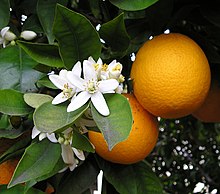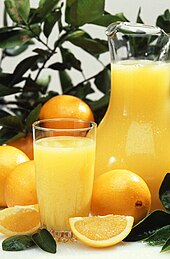橙
| 此條目可參照英語維基百科相應條目來擴充。 |




橙為多種柑橘屬水果的總稱,屬於芸香科(參見被稱為橙的植物列表),一般多指甜橙(學名:Citrus × sinensis)[1] 。另有苦橙(學名: Citrus × aurantium)。甜橙會進行無性生殖,使得各種甜橙通過突變產生。 [2][3][4][5]
橙是柚子(Citrus maxima)和橘(Citrus reticulata)的雜交種[2][6]。橙的葉綠體基因組,也就是母系是柚[7]。甜橙有自己的完整基因組測序。[2]
橙起源於中國南方、印度東北部和緬甸地區[8][9]。在公元前314年,中國文獻最先描述了甜橙[2]。截至1987年[update],人們發現橙樹是世界上最多的耕作果樹[10]。橙樹大量生長於熱帶和亞熱帶地區,以生成橙。橙樹的果實,也就是橙可以直接生吃,或是榨成橙汁和有香氣的橙皮的來源[11]。截至2012年[update],甜橙約佔柑橘屬產量的70%[12]。
在 2017年,全球一共生長了7300萬噸的橙,其中巴西就生長了其中的24% ,緊接着的是中國和印度。[13]
橙內含十分豐富的維生素C,因此在大航海時代,葡萄牙、西班牙和荷蘭的水手在貿易路線上種植柑橘樹以預防壞血病。
歷史[編輯]

甜橙不是一種野果[14],歸因於不純的橘子與雜種柚之間的雜交,而雜種柚具有大量柑的基因。由於其葉綠體DNA是柚子的葉綠體DNA,因此它可能是雜種柚子。它也許是BC1柚子回交的產物,是第一個橙的母本。 [7][15] 根據基因組分析,甜橙中祖先物種的相對比例約為42%的柚子和58%的柑。 [16] 甜橙的所有變種都來自這個原始的雜交品種,僅在農業繁殖過程中選擇的突變有所不同。 [15] 甜橙的起源與苦橙的起源截然不同,苦橙是由純橘子和柚子親本雜交而成的,也許它是在野生環境中獨立產生的。 [15] 最早描述甜橙的中國文獻來自公元前 314 年。[2]
在歐洲,摩爾人將橙引入伊比利亞半島(當時的安達盧斯),從10世紀開始大規模種植。這一點已通過專門用於種植橙果園的複雜灌溉技術得到證明。 [17] 柑橘類水果-其中包括苦橙-在西西里酋長國時期於9世紀引入西西里島,但是直到15世紀末或16世紀初,甜橙才廣為人知。這時是意大利和葡萄牙商人將橘子樹帶入地中海地區的時候。 [10] 此後不久,甜橙迅速被用作可食用的水果。它也被認為是奢侈品,有錢人會在私人音樂學校種橘子,稱為orangerie。1646年,甜橙在整個歐洲廣為人知。 [10] 法國的路易十四非常喜歡橘子樹,並在凡爾賽宮建造了最宏偉的凡爾賽宮橘子室。 [18] 在凡爾賽宮,宮殿的整個房間都擺放着用實心銀盆栽栽種的橘子樹,而橘園則允許全年種植這種水果,以供宮廷使用。 1664年,路易十四譴責其財政部長尼古拉斯·富凱時,他沒收的部分寶藏是位於子爵城堡的富凱莊園的一千多棵橘樹。 [19]
參考資料[編輯]
- ^ Citrus ×sinensis (L.) Osbeck (pro sp.) (maxima × reticulata) sweet orange. Plants.USDA.gov. (原始內容存檔於2011-05-12).
- ^ 2.0 2.1 2.2 2.3 2.4 Xu, Q; Chen, LL; Ruan, X; Chen, D; Zhu, A; Chen, C; Bertrand, D; Jiao, WB; Hao, BH; Lyon, MP; Chen, J; Gao, S; Xing, F; Lan, H; Chang, JW; Ge, X; Lei, Y; Hu, Q; Miao, Y; Wang, L; Xiao, S; Biswas, MK; Zeng, W; Guo, F; Cao, H; Yang, X; Xu, XW; Cheng, YJ; Xu, J; Liu, JH; Luo, OJ; Tang, Z; Guo, WW; Kuang, H; Zhang, HY; Roose, ML; Nagarajan, N; Deng, XX; Ruan, Y. The draft genome of sweet orange (Citrus sinensis). Nature Genetics. Jan 2013, 45 (1): 59–66. PMID 23179022. doi:10.1038/ng.2472
 .
.
- ^ Orange Fruit Information. 2017-06-09 [2018-09-20]. (原始內容存檔於2019-06-01).
- ^ Orange fruit nutrition facts and health benefits. [2018-09-20]. (原始內容存檔於2009-08-21).
- ^ Oranges: Health Benefits, Risks & Nutrition Facts. [2018-09-20]. (原始內容存檔於2014-04-25).
- ^ Andrés García Lor. Organización de la diversidad genética de los cítricos (PDF) (學位論文): 79. 2013 [2021-07-06]. (原始內容存檔 (PDF)於2021-02-25).
- ^ 7.0 7.1 Velasco, R; Licciardello, C. A genealogy of the citrus family. Nature Biotechnology. 2014, 32 (7): 640–642. PMID 25004231. S2CID 9357494. doi:10.1038/nbt.2954.
- ^ Morton, Julia F. Fruits of Warm Climates. 1987: 134–142 [2021-01-30]. (原始內容存檔於2019-05-26).
- ^ Talon, Manuel; Caruso, Marco; Gmitter, Jr., Fred G. The Genus Citrus. Woodhead Publishing. 2020: 17 [2021-01-30]. ISBN 9780128122174. (原始內容存檔於2020-08-19).
- ^ 10.0 10.1 10.2 Morton, J. Orange, Citrus sinensis. In: Fruits of Warm Climates. NewCROP, New Crop Resource Online Program, Center for New Crops & Plant Products, Purdue University: 134–142. 1987 [2021-01-30]. (原始內容存檔於2000-11-10).
- ^ Citrus sinensis. Germplasm Resources Information Network (GRIN). USDA.
- ^ Organisms. Citrus Genome Database. (原始內容存檔於2012-08-24) (英語).
- ^ Production of oranges, 2017 – choose "Production, Crops, World Regions" in the left margin and picklist. United Nations, Food and Agricultural Organization, FAO Statistics. 2018 [2019-07-23]. 原始內容存檔於2023-05-28.
- ^ Hodgson, Willard. Chapter 4: Horticultural Varieties of Citrus. Webber, Herbert John; rev Walter Reuther and Harry W. Lawton (編). The Citrus Industry. Riverside, California: University of California Division of Agricultural Sciences. 1967–1989 [1943]. (原始內容存檔於2012-02-05).
- ^ 15.0 15.1 15.2 G Albert Wu; et al. Sequencing of diverse mandarin, pomelo and orange genomes reveals complex history of admixture during citrus domestication. Nature Biotechnology. 2014, 32 (7): 656–662. PMC 4113729
 . PMID 24908277. doi:10.1038/nbt.2906.
. PMID 24908277. doi:10.1038/nbt.2906.
- ^ Wu, Guohong Albert; Terol, Javier; Ibanez, Victoria; López-García, Antonio; Pérez-Román, Estela; Borredá, Carles; Domingo, Concha; Tadeo, Francisco R; Carbonell-Caballero, Jose; Alonso, Roberto; Curk, Franck; Du, Dongliang; Ollitrault, Patrick; Roose, Mikeal L. Roose; Dopazo, Joaquin; Gmitter Jr, Frederick G.; Rokhsar, Daniel; Talon, Manuel. Genomics of the origin and evolution of Citrus. Nature. 2018, 554 (7692): 311–316. Bibcode:2018Natur.554..311W. PMID 29414943. doi:10.1038/nature25447
 . and Supplement
. and Supplement
- ^ Trillo San José, Carmen. Water and landscape in Granada. Universidad de Granada. 2003-09-01 [2021-04-02]. (原始內容存檔於2020-08-11).
- ^ Jean-Baptiste Leroux. The Gardens of Versailles. Thames & Hudson. 2002: 368.
- ^ Nancy Mitford. The Sun King. Sphere Books Ltd. 1966: 11.
外部連結[編輯]
| 維基語錄上的Oranges語錄 |
| 查看維基詞典中的詞條「橙」。 |
 維基共享資源上的相關多媒體資源:橙
維基共享資源上的相關多媒體資源:橙 維基物種上的相關資訊:橙
維基物種上的相關資訊:橙- Citrus sinensis List of Chemicals (Dr. Duke's Phytochemical and Ethnobotanical Databases), USDA, Agricultural Research Service.
- Oranges: Safe Methods to Store, Preserve, and Enjoy. (2006). University of California Agriculture and Natural Resources. Accessed May 23, 2014.
| ||||||||||||||||||||||||||||||||||||||||||||||||||||||||||||||||||||||||||||||||||||||||||||||||||||||||||||||||||||||||||||
